SemanticKernel如何基于自有数据聊天
效果
使用gpt-3.5-turbo的效果
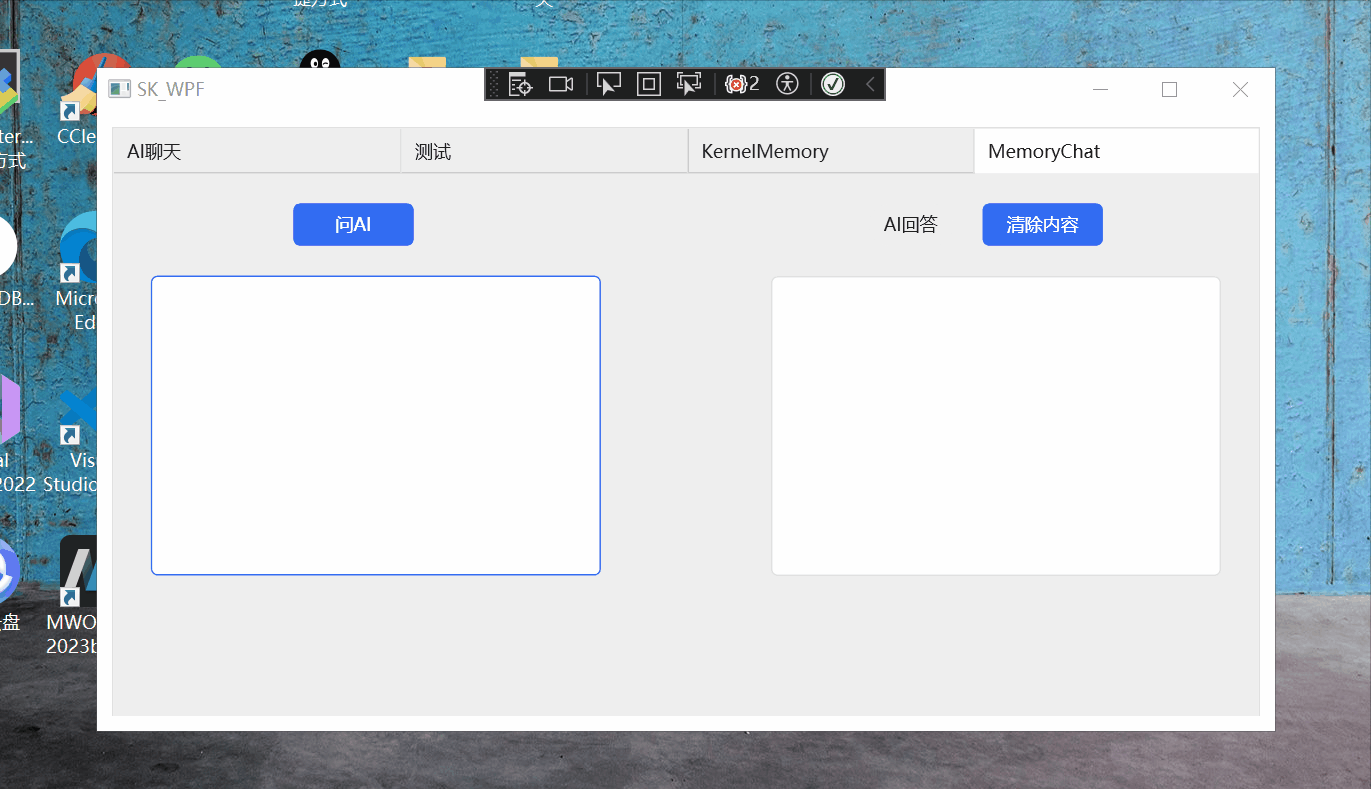
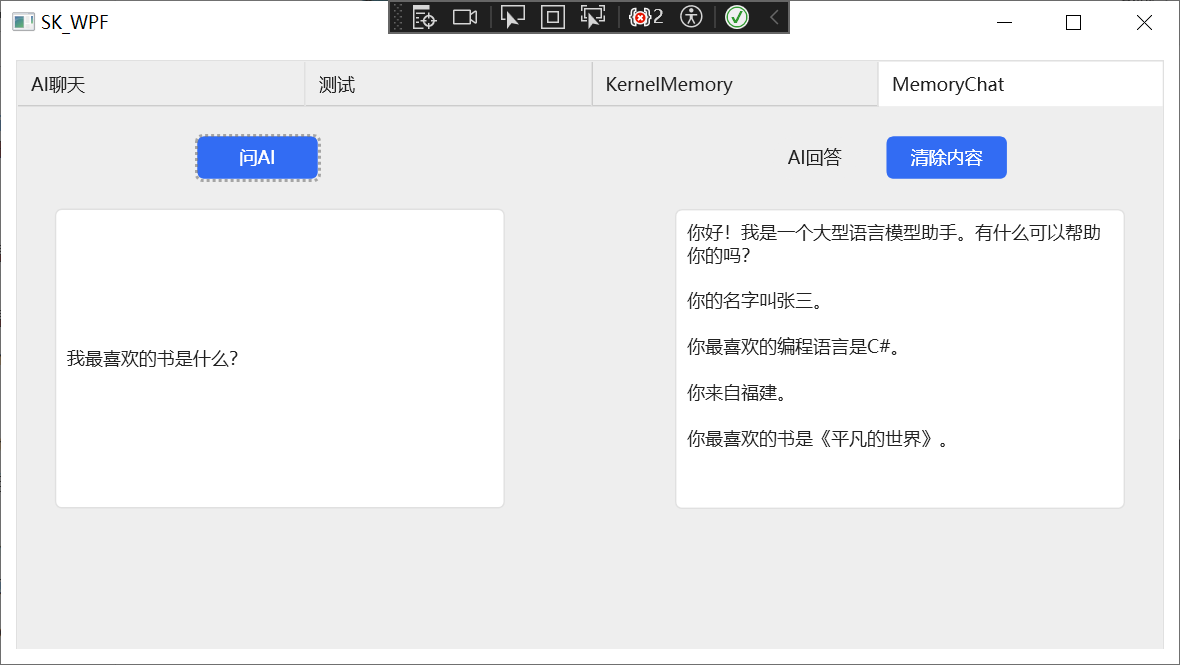
什么是向量数据库?
向量数据库是一种专为处理高维向量数据而设计的数据库系统。与传统的关系型数据库不同,向量数据库专注于存储和查询向量数据,例如图像、音频、文本等。其核心思想是将数据表示为向量形式,并通过向量之间的相似度来进行查询和分析。
向量数据库的特点包括高效的相似度搜索和复杂的查询操作。通过利用向量之间的相似度,可以快速检索与查询向量相似的数据,适用于大规模数据集和高维度数据。此外,向量数据库还支持复杂的查询操作,如范围查询、聚类和聚合等。
在实际应用中,向量数据库被广泛用于图像搜索、推荐系统、自然语言处理等领域。例如,在图像搜索中,可以利用向量数据库来存储图像的特征向量,并通过计算相似度来实现快速的图像检索。在推荐系统中,可以利用用户的特征向量来实现个性化推荐。
总之,向量数据库是一种适用于处理高维向量数据的数据库系统,具有高效的相似度搜索和复杂的查询操作,广泛应用于图像搜索、推荐系统等领域。
什么是嵌入?
嵌入是一种在高维空间中将单词或其他数据表示为向量的方法。向量就像有方向和长度的箭头。高维意味着空间有很多维度,比我们能看到或想象的要多。这个想法是,相似的单词或数据将具有相似的向量,而不同的单词或数据将具有不同的向量。这有助于我们衡量它们的相关或不相关程度,并对它们进行操作,例如加、减、乘等。嵌入对 AI 模型很有用,因为它们可以以计算机可以理解和处理的方式捕获单词或数据的含义和上下文。
所以基本上你拿一个句子、段落或整页文本,然后生成相应的嵌入向量。当执行查询时,查询将转换为其嵌入表示形式,然后通过所有现有的嵌入向量执行搜索以找到最相似的嵌入向量。这类似于在必应上进行搜索查询时,它会为您提供与查询近似的多个结果。语义记忆不太可能给你一个完全匹配,但它总是会给你一组匹配,根据你的查询与其他文本的相似程度进行排名。
Chroma向量数据库
在本示例中,我使用的是Chroma向量数据库。
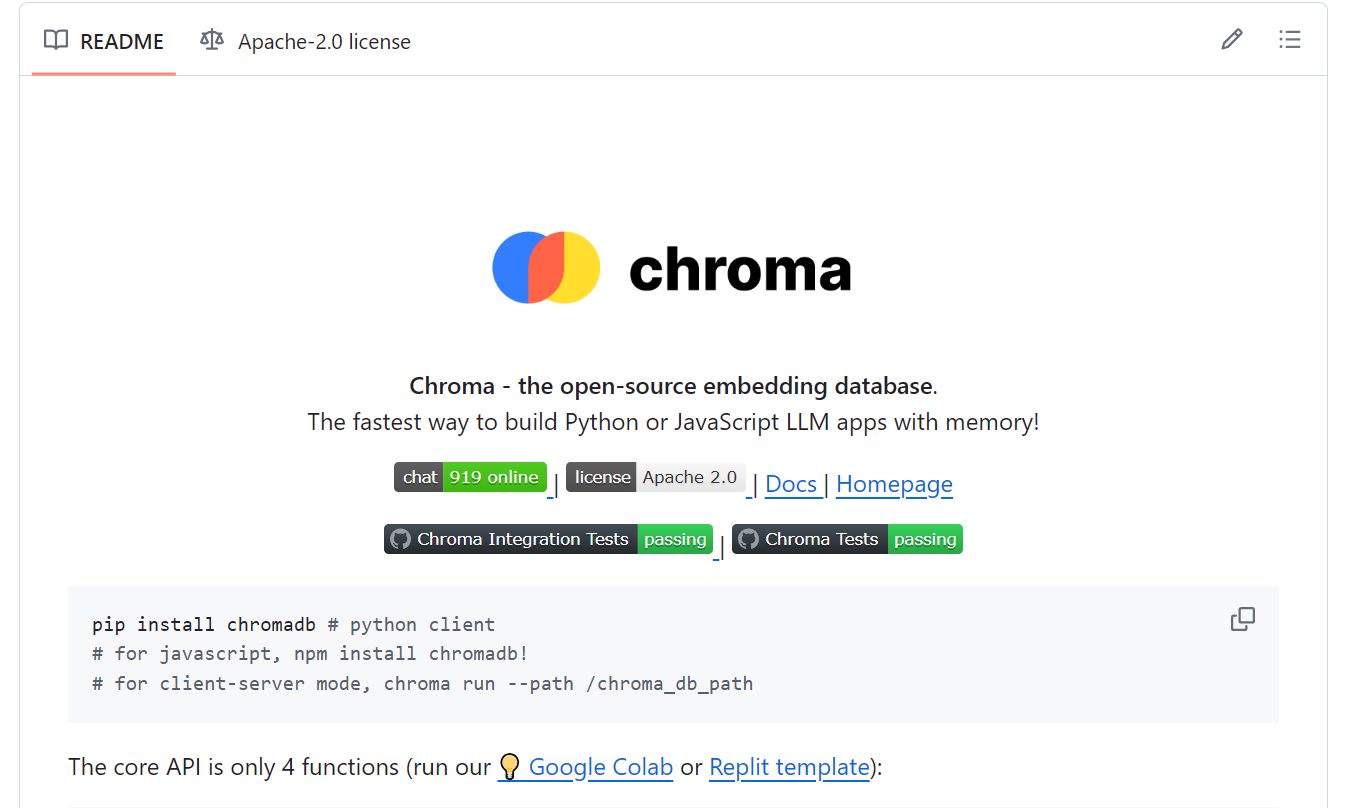
在docker中运行chroma:
docker pull chromadb/chroma
docker run -p 8000:8000 chromadb/chroma
成功启动如下所示:

创建ISemanticTextMemory
因为向量数据库使用的是Chroma,因此需要下载这个包:

#pragma warning disable SKEXP0003
ISemanticTextMemory? memory;
#pragma warning disable SKEXP0003
var memoryBuilder = new MemoryBuilder();
#pragma warning disable SKEXP0011
memoryBuilder.WithOpenAITextEmbeddingGeneration("text-embedding-ada-002", envVars["OpenAIAPIKey"]);
#pragma warning disable SKEXP0022
var chromaMemoryStore = new ChromaMemoryStore("http://127.0.0.1:8000");
memoryBuilder.WithMemoryStore(chromaMemoryStore);
memory = memoryBuilder.Build();
ISemanticTextMemory
语义记忆的接口,用于创建和调用与文本相关的记忆。
WithOpenAITextEmbeddingGeneration
添加 OpenAI 文本嵌入服务。
ChromaMemoryStore
用于 Chroma 的 IMemoryStore 的实现。
本地需要开启Chroma服务。
保存自有数据
// 创建 OpenFileDialog 对象
OpenFileDialog openFileDialog = new OpenFileDialog();
// 设置文件类型过滤器
openFileDialog.Filter = "Text files (*.txt)|*.txt|All files (*.*)|*.*";
// 显示文件选择对话框
if (openFileDialog.ShowDialog() == true)
{
// 用户选择了一个文件,你可以通过 openFileDialog.FileName 获取文件的路径
string filePath = openFileDialog.FileName;
HandyControl.Controls.MessageBox.Show($"你选中的路径为{filePath}");
var text = File.ReadAllText(filePath);
const string MemoryCollectionName = "hello2";
var id = Guid.NewGuid().ToString();
await memory.SaveInformationAsync(MemoryCollectionName, id: id, text: text);
HandyControl.Controls.MessageBox.Show($"完成");
这是以选择一个txt文件为例,核心就一行代码:
await memory.SaveInformationAsync(MemoryCollectionName, id: id, text: text);
将一些信息保存到Semantic Memory中。
查看该方法的定义:
Task<string> SaveInformationAsync(string collection, string text, string id, string? description = null, string? additionalMetadata = null, Kernel? kernel = null, CancellationToken cancellationToken = default(CancellationToken));
参数及含义:
| 参数名 | 类型 | 含义 |
|---|---|---|
| collection | string | 保存数据的集合名 |
| text | string | 要保存的数据 |
| id | string | 唯一标识符 |
| description | string? | 描述 |
| additionalMetadata | string? | 额外的元数据 |
| kernel | Kernel? | 包含服务、插件和其他状态的内核,供整个操作使用 |
| cancellationToken | CancellationToken | 用于监视取消请求的 CancellationToken。默认值为 None |
前面三项是必填的,其他项都有默认值。
const string MemoryCollectionName = "hello2";
经过我的测试,集合名要是英文,中文会报错。
创建TextMemoryPlugin
代码如下所示:
/// <summary>
/// TextMemoryPlugin provides a plugin to save or recall information from the long or short term memory.
/// </summary>
[Experimental("SKEXP0003")]
public sealed class TextMemoryPlugin
{
/// <summary>
/// Name used to specify the input text.
/// </summary>
public const string InputParam = "input";
/// <summary>
/// Name used to specify which memory collection to use.
/// </summary>
public const string CollectionParam = "collection";
/// <summary>
/// Name used to specify memory search relevance score.
/// </summary>
public const string RelevanceParam = "relevance";
/// <summary>
/// Name used to specify a unique key associated with stored information.
/// </summary>
public const string KeyParam = "key";
/// <summary>
/// Name used to specify the number of memories to recall
/// </summary>
public const string LimitParam = "limit";
private const string DefaultCollection = "generic";
private const double DefaultRelevance = 0.0;
private const int DefaultLimit = 1;
private readonly ISemanticTextMemory _memory;
private readonly ILogger _logger;
/// <summary>
/// Creates a new instance of the TextMemoryPlugin
/// </summary>
public TextMemoryPlugin(
ISemanticTextMemory memory,
ILoggerFactory? loggerFactory = null)
{
this._memory = memory;
this._logger = loggerFactory?.CreateLogger(typeof(TextMemoryPlugin)) ?? NullLogger.Instance;
}
/// <summary>
/// Key-based lookup for a specific memory
/// </summary>
/// <param name="key">The key associated with the memory to retrieve.</param>
/// <param name="collection">Memories collection associated with the memory to retrieve</param>
/// <param name="cancellationToken">The <see cref="CancellationToken"/> to monitor for cancellation requests. The default is <see cref="CancellationToken.None"/>.</param>
[KernelFunction, Description("Key-based lookup for a specific memory")]
public async Task<string> RetrieveAsync(
[Description("The key associated with the memory to retrieve")] string key,
[Description("Memories collection associated with the memory to retrieve")] string? collection = DefaultCollection,
CancellationToken cancellationToken = default)
{
if (this._logger.IsEnabled(LogLevel.Debug))
{
this._logger.LogDebug("Recalling memory with key '{0}' from collection '{1}'", key, collection);
}
var memory = await this._memory.GetAsync(collection, key, cancellationToken: cancellationToken).ConfigureAwait(false);
return memory?.Metadata.Text ?? string.Empty;
}
/// <summary>
/// Semantic search and return up to N memories related to the input text
/// </summary>
/// <param name="input">The input text to find related memories for.</param>
/// <param name="collection">Memories collection to search.</param>
/// <param name="relevance">The relevance score, from 0.0 to 1.0, where 1.0 means perfect match.</param>
/// <param name="limit">The maximum number of relevant memories to recall.</param>
/// <param name="cancellationToken">The <see cref="CancellationToken"/> to monitor for cancellation requests. The default is <see cref="CancellationToken.None"/>.</param>
[KernelFunction, Description("Semantic search and return up to N memories related to the input text")]
public async Task<string> RecallAsync(
[Description("The input text to find related memories for")] string input,
[Description("Memories collection to search")] string collection = DefaultCollection,
[Description("The relevance score, from 0.0 to 1.0, where 1.0 means perfect match")] double? relevance = DefaultRelevance,
[Description("The maximum number of relevant memories to recall")] int? limit = DefaultLimit,
CancellationToken cancellationToken = default)
{
relevance ??= DefaultRelevance;
limit ??= DefaultLimit;
if (this._logger.IsEnabled(LogLevel.Debug))
{
this._logger.LogDebug("Searching memories in collection '{0}', relevance '{1}'", collection, relevance);
}
// Search memory
List<MemoryQueryResult> memories = await this._memory
.SearchAsync(collection, input, limit.Value, relevance.Value, cancellationToken: cancellationToken)
.ToListAsync(cancellationToken)
.ConfigureAwait(false);
if (memories.Count == 0)
{
if (this._logger.IsEnabled(LogLevel.Warning))
{
this._logger.LogWarning("Memories not found in collection: {0}", collection);
}
return string.Empty;
}
return limit == 1 ? memories[0].Metadata.Text : JsonSerializer.Serialize(memories.Select(x => x.Metadata.Text));
}
/// <summary>
/// Save information to semantic memory
/// </summary>
/// <param name="input">The information to save</param>
/// <param name="key">The key associated with the information to save</param>
/// <param name="collection">Memories collection associated with the information to save</param>
/// <param name="cancellationToken">The <see cref="CancellationToken"/> to monitor for cancellation requests. The default is <see cref="CancellationToken.None"/>.</param>
[KernelFunction, Description("Save information to semantic memory")]
public async Task SaveAsync(
[Description("The information to save")] string input,
[Description("The key associated with the information to save")] string key,
[Description("Memories collection associated with the information to save")] string collection = DefaultCollection,
CancellationToken cancellationToken = default)
{
if (this._logger.IsEnabled(LogLevel.Debug))
{
this._logger.LogDebug("Saving memory to collection '{0}'", collection);
}
await this._memory.SaveInformationAsync(collection, text: input, id: key, cancellationToken: cancellationToken).ConfigureAwait(false);
}
/// <summary>
/// Remove specific memory
/// </summary>
/// <param name="key">The key associated with the information to save</param>
/// <param name="collection">Memories collection associated with the information to save</param>
/// <param name="cancellationToken">The <see cref="CancellationToken"/> to monitor for cancellation requests. The default is <see cref="CancellationToken.None"/>.</param>
[KernelFunction, Description("Remove specific memory")]
public async Task RemoveAsync(
[Description("The key associated with the information to save")] string key,
[Description("Memories collection associated with the information to save")] string collection = DefaultCollection,
CancellationToken cancellationToken = default)
{
if (this._logger.IsEnabled(LogLevel.Debug))
{
this._logger.LogDebug("Removing memory from collection '{0}'", collection);
}
await this._memory.RemoveAsync(collection, key, cancellationToken: cancellationToken).ConfigureAwait(false);
}
}
比较长,可以以后用到了什么函数再慢慢看,等一会我们就要接触到的函数如下:
/// <summary>
/// Semantic search and return up to N memories related to the input text
/// </summary>
/// <param name="input">The input text to find related memories for.</param>
/// <param name="collection">Memories collection to search.</param>
/// <param name="relevance">The relevance score, from 0.0 to 1.0, where 1.0 means perfect match.</param>
/// <param name="limit">The maximum number of relevant memories to recall.</param>
/// <param name="cancellationToken">The <see cref="CancellationToken"/> to monitor for cancellation requests. The default is <see cref="CancellationToken.None"/>.</param>
[KernelFunction, Description("Semantic search and return up to N memories related to the input text")]
public async Task<string> RecallAsync(
[Description("The input text to find related memories for")] string input,
[Description("Memories collection to search")] string collection = DefaultCollection,
[Description("The relevance score, from 0.0 to 1.0, where 1.0 means perfect match")] double? relevance = DefaultRelevance,
[Description("The maximum number of relevant memories to recall")] int? limit = DefaultLimit,
CancellationToken cancellationToken = default)
{
relevance ??= DefaultRelevance;
limit ??= DefaultLimit;
if (this._logger.IsEnabled(LogLevel.Debug))
{
this._logger.LogDebug("Searching memories in collection '{0}', relevance '{1}'", collection, relevance);
}
// Search memory
List<MemoryQueryResult> memories = await this._memory
.SearchAsync(collection, input, limit.Value, relevance.Value, cancellationToken: cancellationToken)
.ToListAsync(cancellationToken)
.ConfigureAwait(false);
if (memories.Count == 0)
{
if (this._logger.IsEnabled(LogLevel.Warning))
{
this._logger.LogWarning("Memories not found in collection: {0}", collection);
}
return string.Empty;
}
return limit == 1 ? memories[0].Metadata.Text : JsonSerializer.Serialize(memories.Select(x => x.Metadata.Text));
}
一步一步来看:
[KernelFunction, Description("Semantic search and return up to N memories related to the input text")]
KernelFunction是一个特性,可能是用于标记这个方法作为某种内核函数的一部分。具体的含义取决于这个特性是如何在代码中被使用的。
Description 是.NET框架中的一个标准特性,它提供了一个人类可读的描述,这个描述可以在运行时通过反射来访问。在这个例子中,它提供了对 RecallAsync 方法的简单描述:"Semantic search and return up to N memories related to the input text"。
public async Task<string> RecallAsync(
[Description("The input text to find related memories for")] string input,
[Description("Memories collection to search")] string collection = DefaultCollection,
[Description("The relevance score, from 0.0 to 1.0, where 1.0 means perfect match")] double? relevance = DefaultRelevance,
[Description("The maximum number of relevant memories to recall")] int? limit = DefaultLimit,
CancellationToken cancellationToken = default)
RecallAsync方法有input、collection、relevance、limit、cancellationToken参数,它们的含义如下:
| 参数名 | 含义 |
|---|---|
| input | 用于查看向量数据库中是否有相关数据的文本 |
| collection | 向量数据库中的集合名 |
| relevance | 相关性,0最低,1最高 |
| limit | 相关数据的最大返回数量 |
| cancellationToken | .NET中用于协调取消长时间运行的操作的结构 |
在向量数据库中查找相关数据:
// Search memory
List<MemoryQueryResult> memories = await this._memory
.SearchAsync(collection, input, limit.Value, relevance.Value, cancellationToken: cancellationToken)
.ToListAsync(cancellationToken)
.ConfigureAwait(false);
向kernel导入插件:
// TextMemoryPlugin provides the "recall" function
kernel.ImportPluginFromObject(new TextMemoryPlugin(memory));
开始测试
用于测试的本地数据:
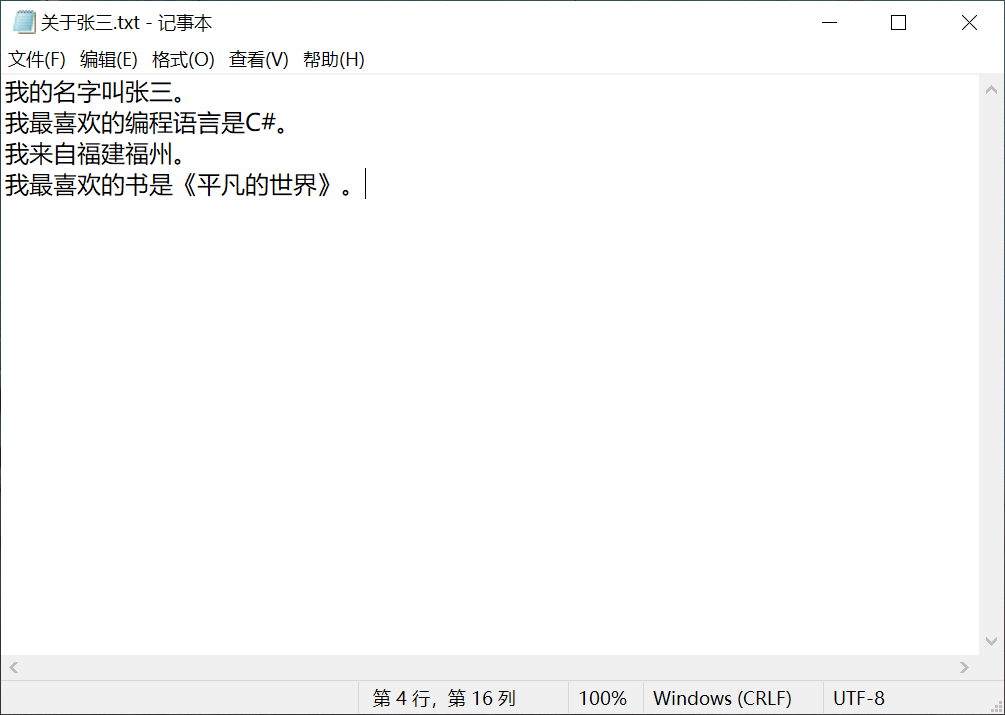
这些数据大语言模型肯定不会知道的。
导入文件之后,开始测试:
const string skPrompt = @"
ChatBot can have a conversation with you about any topic.
It can give explicit instructions or say 'I don't know' if it does not have an answer.
Information about me, from previous conversations:
- {{$fact1}} {{recall $fact1}}
- {{$fact2}} {{recall $fact2}}
Chat:
{{$history}}
User: {{$userInput}}
ChatBot: ";
var chatFunction = kernel.CreateFunctionFromPrompt(skPrompt, new OpenAIPromptExecutionSettings { MaxTokens = 200, Temperature = 0.8 });
#pragma warning disable SKEXP0052
var arguments = new KernelArguments();
arguments["fact1"] = "我的名字是什么?";
arguments["fact2"] = "我喜欢什么编程语言?";
arguments[TextMemoryPlugin.CollectionParam] = "hello2";
arguments[TextMemoryPlugin.LimitParam] = "2";
arguments[TextMemoryPlugin.RelevanceParam] = "0.8";
arguments["userInput"] = "我的名字叫什么?";
// Process the user message and get an answer
var answer = await chatFunction.InvokeAsync(kernel, arguments);
Debug.WriteLine(answer);
在查找“我的名字是什么?”时,并没有查找到相关内容:

在查看“我喜欢什么编程语言?”时,找到了相关内容:

查看查找到的相关内容:
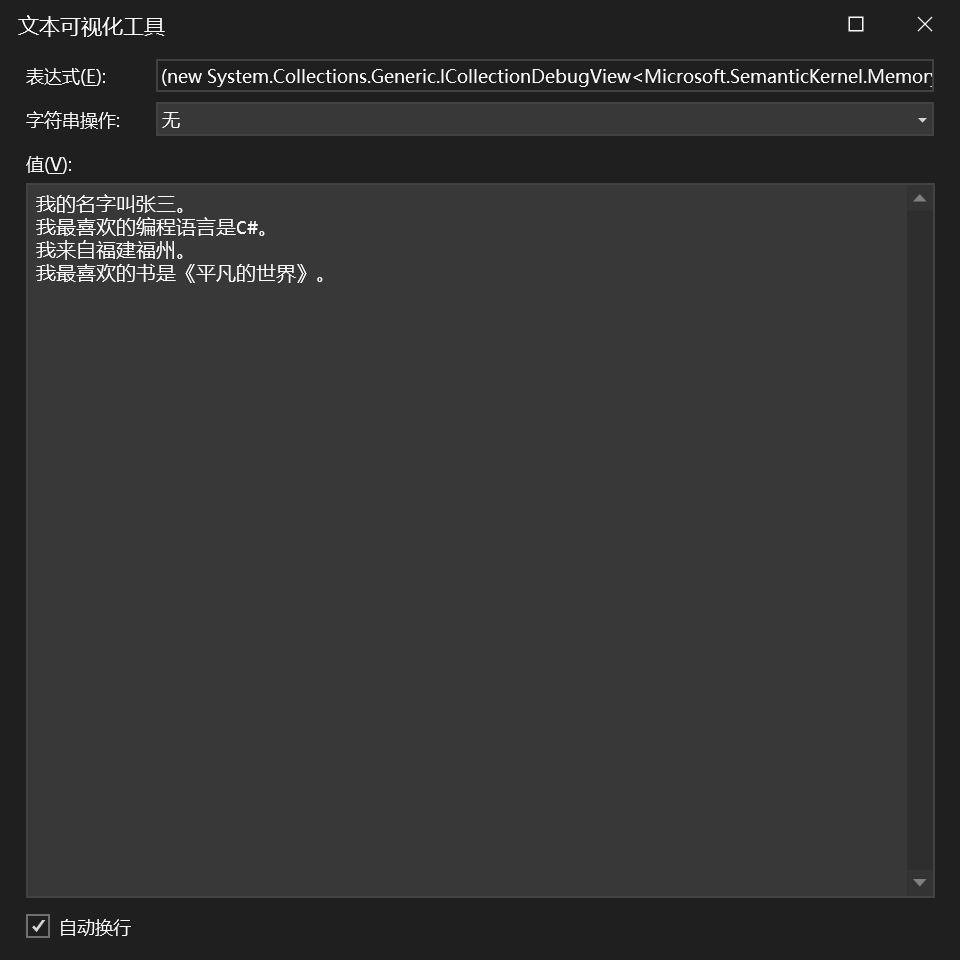
大语言模型可以根据获取到的数据进行回答:

MemoryChat
经过测试,我们发现是可行的,就可以写成问答的形式:
loadingMemory2.Visibility = Visibility.Visible;
string question = textBoxMemory1.Text;
// Get user input
history.AddUserMessage(question);
const string skPrompt = @"
ChatBot can have a conversation with you about any topic.
It can give explicit instructions or say 'I don't know' if it does not have an answer.
Information about me, from previous conversations:
- {{$fact1}} {{recall $fact1}}
Chat:
{{$history}}
User: {{$userInput}}
ChatBot: ";
var chatFunction = kernel.CreateFunctionFromPrompt(skPrompt, new OpenAIPromptExecutionSettings { MaxTokens = 200, Temperature = 0.8 });
#pragma warning disable SKEXP0052
var arguments = new KernelArguments();
arguments["fact1"] = question;
arguments[TextMemoryPlugin.CollectionParam] = "hello2";
arguments[TextMemoryPlugin.LimitParam] = "2";
arguments[TextMemoryPlugin.RelevanceParam] = "0.6";
arguments["userInput"] = question;
// Process the user message and get an answer
var answer = await chatFunction.InvokeAsync(kernel, arguments);
Debug.WriteLine(answer);
// Print the results
richTextBoxMemory.AppendText(answer + "\r\n");
// Add the message from the agent to the chat history
history.AddMessage(Microsoft.SemanticKernel.ChatCompletion.AuthorRole.System, answer.ToString());
loadingMemory2.Visibility = Visibility.Hidden;
使用gpt-3.5-turbo的效果


使用gemini-pro的效果
只对了一个最喜欢的编程语言问题。
使用讯飞星火认知大模型的效果
一个都没答对。
参考
1、Understanding AI plugins in Semantic Kernel and beyond | Microsoft Learn
2、Memories in Semantic Kernel | Microsoft Learn
3、LLM AI Embeddings | Microsoft Learn
4、Vector Database | Microsoft Learn
SemanticKernel如何基于自有数据聊天的更多相关文章
- Android 基于Socket的聊天应用(二)
很久没写BLOG了,之前在写Android聊天室的时候答应过要写一个客户(好友)之间的聊天demo,Android 基于Socket的聊天室已经实现了通过Socket广播形式的通信功能. 以下是我写的 ...
- openfire:基于开源 Openfire 聊天服务器 - 开发Openfire聊天记录插件
基于开源 Openfire 聊天服务器 - 开发Openfire聊天记录插件 上一篇文章介绍到怎么在自己的Java环境中搭建openfire插件开发的环境,同时介绍到怎样一步步简单的开发openfir ...
- 基于开源 Openfire 聊天服务器 - 开发Openfire聊天记录插件
原文:http://www.cnblogs.com/hoojo/archive/2013/03/29/openfire_plugin_chatlogs_plugin_.html 随笔-150 评论- ...
- 基于WebSocket实现聊天室(Node)
基于WebSocket实现聊天室(Node) WebSocket是基于TCP的长连接通信协议,服务端可以主动向前端传递数据,相比比AJAX轮询服务器,WebSocket采用监听的方式,减轻了服务器压力 ...
- IP报文解析及基于IP 数据包的洪水攻击
版本(4bit) 报头长度(4bit) 优先级和服务类型(8bit) 总长度(16bit) 标识(16bit) 标志(3bit) 分段偏移(13bit) 存活期(8bit) 协议(8bit) 报头校验 ...
- H2O是开源基于大数据的机器学习库包
H2O是开源基于大数据的机器学习库包 H2O能够让Hadoop做数学,H2O是基于大数据的 统计分析 机器学习和数学库包,让用户基于核心的数学积木搭建应用块代码,采取类似R语言 Excel或JSON等 ...
- 基于GPS数据建立隐式马尔可夫模型预测目的地
<Trip destination prediction based on multi-day GPS data>是一篇在2019年,由吉林交通大学团队发表在elsevier期刊上的一篇论 ...
- Ext JS学习第十六天 事件机制event(一) DotNet进阶系列(持续更新) 第一节:.Net版基于WebSocket的聊天室样例 第十五节:深入理解async和await的作用及各种适用场景和用法 第十五节:深入理解async和await的作用及各种适用场景和用法 前端自动化准备和详细配置(NVM、NPM/CNPM、NodeJs、NRM、WebPack、Gulp/Grunt、G
code&monkey Ext JS学习第十六天 事件机制event(一) 此文用来记录学习笔记: 休息了好几天,从今天开始继续保持更新,鞭策自己学习 今天我们来说一说什么是事件,对于事件 ...
- 基于MNIST数据的卷积神经网络CNN
基于tensorflow使用CNN识别MNIST 参数数量:第一个卷积层5x5x1x32=800个参数,第二个卷积层5x5x32x64=51200个参数,第三个全连接层7x7x64x1024=3211 ...
- 基于ifc数据的bim模型吊装模拟-1
基于ifc数据的bim模型吊装模拟-1 IfcWallStandardCase IfcColumn
随机推荐
- 【JS 逆向百例】Fiddler 插件 Hook 实战,某创帮登录逆向
关注微信公众号:K哥爬虫,QQ交流群:808574309,持续分享爬虫进阶.JS/安卓逆向等技术干货! 声明 本文章中所有内容仅供学习交流,抓包内容.敏感网址.数据接口均已做脱敏处理,严禁用于商业用途 ...
- win10家庭版禁用更新
前言 2020年初因为疫情在家远程办公,而我老家没有电脑,先后向两位大学生借了两台电脑来办公,发现一个现象:他们的电脑系统都是家庭版,也就是刚买电脑时安装的win10家庭版.也问了其它几位计算机专业的 ...
- 用npm查看可安装的包版本
1.查看包版本命令 npm view less-loader versions
- Windows安装MySQL到最后卡主无响应处理办法
安装mysql-5.5.62-winx64到最后Ready to execute ... 生效配置时卡主无响应 最有效,最快的解决办法 就是:重启电脑 或者 关闭电脑,在开机,找到MySQL安装目录, ...
- workman在线五子棋
一.下载安装workman,地址:https://github.com/walkor/workerman composer require workerman/workerman 二.cd到worke ...
- 洛谷P2241 统计方形 ,棋盘问题升级板,给出格子坐标中矩形以及正方形的计算方法
在做这道题之前我们先了解一下棋盘问题 棋盘问题 (qq.com) 对于棋盘问题,我们可以得出对于一个n*n的正方形方格阵如何求其包含的正方形个数 也就是数每个正方形的中间点,然后将其点排列 ...
- 记录一则ADG备库报错ORA-29771的案例
有客户找到我这边咨询,说他们的一套核心ADG库在业务高峰期报错,因为业务做了读写分离,其备库也实际承担读业务,所以备库故障也会对业务产生影响. 这里也要提醒大家,做读写分离,如果读库出现故障的情况,要 ...
- HttpClientTemplate JDK11以上的版本,可以用,我写的。
package com.diandaxia.common.template; import com.fasterxml.jackson.databind.ObjectMapper; import or ...
- NVME(学习杂谈)—Asynchronous Event
Asynchronous Event Request Host Software Recommendations 当一个异步事件请求完成(提供Event Type,Event Information, ...
- 轻松玩转makefile|基础知识
1.什么是Makefile 在嵌入式软件开发领域,使用 make 工具构建开发环境是非常常见的.而要使用 make 工具,就需要编写 Makefile 文件来定义一系列规则,指定需要先编译.后编译 ...
